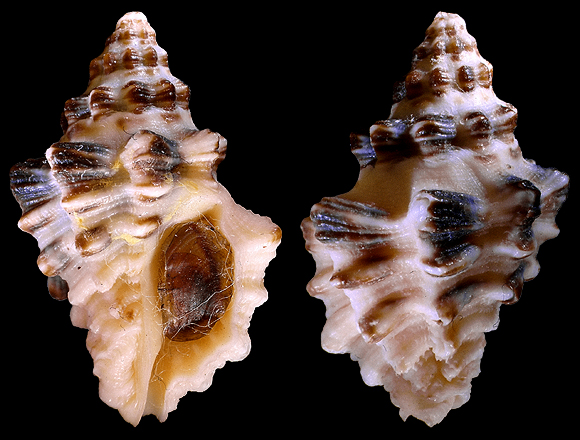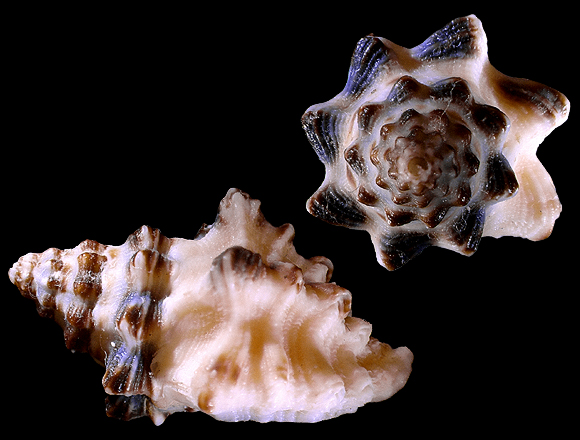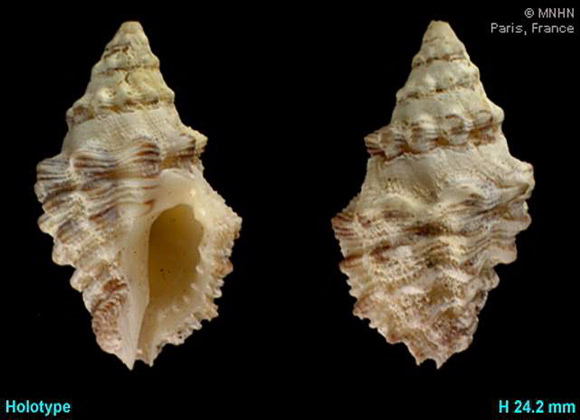
Endemic to Persian Gulf & Oman. Introduced in eastern Mediterranean (SE. Turkey in 1995, Cyprus in 1997). Predator in shallow rocky environments. Basionym: Pentadactylus martensi. Often confused with Ergalatax junionae Houart, 2008, it is sometimes listed under the name Ergalatax obscura Houart, 1996. Aperture yellow.
Shell « heavy, stout. Spire high with 3+ protoconch whorls […] and up to 7 broad, strongly shouldered teleoconch whorls. Suture adpressed. Ptotoconch conical, acute, whorls smooth. Axial sculpture of teleoconch whorls consisting of high, rounded, nodose ribs: 10 or 11 from first to penultimate whorl, 6 to 8 on last whorl, rarely 5 or 9. Spiral sculpture of high, strong, primary, secondary and tertiary cords. […] Sculpture forming high, nodose knobs at intersection of spiral cords and axial ribs. » – R. Houart: “Rehabilitation of Ergalatax martensi…” The Nautilus 122(2) 2008, p.100.
Shell « heavy, stout. Spire high with 3+ protoconch whorls […] and up to 7 broad, strongly shouldered teleoconch whorls. Suture adpressed. Ptotoconch conical, acute, whorls smooth. Axial sculpture of teleoconch whorls consisting of high, rounded, nodose ribs: 10 or 11 from first to penultimate whorl, 6 to 8 on last whorl, rarely 5 or 9. Spiral sculpture of high, strong, primary, secondary and tertiary cords. […] Sculpture forming high, nodose knobs at intersection of spiral cords and axial ribs. » – R. Houart: “Rehabilitation of Ergalatax martensi…” The Nautilus 122(2) 2008, p.100.
Above and below:
4m deep, Taşucu, Silifke, Mersin province, SE. Turkey. 24,5mm.

« Aperture relatively small, ovate. Columellar lip with 2 or 3 weak knobs abapically, rim adherent. Anal notch broad, moderately deep. Outer lip weakly crenulate, with 7 strong elongate denticles within […] Siphonal canal short, broadly open. Milky white, creamy white, or tan, usually with some light to dark brown colored spiral cords on shoulder and on more prominent nodes. Aperture cream or pale yellow within. »

« This shell, according to Prof. von Martens, belongs to Ricinula siderea, as described in Vorderasiatische Conchylien pag. 95, and figured Pl.5, fig.49. Though I cannot see every character named there, a. o. not the upper row of spots near the suture, the specimens agree in most
respects, especially the narrow ones. Prof. v. Martens, however, says that he is now doubtful, if his identification with R. siderea is right, and that if not, the species should receive a new name; thus I sent a specimen to Mr. Smith, who declared it to be different from the specimens of siderea in the British Museum. » – M. M. schepman: “Two supposed new species of Pentadactylus”, Notes from the Leyden Museum vol. XV, Leyden 1893, p.104.